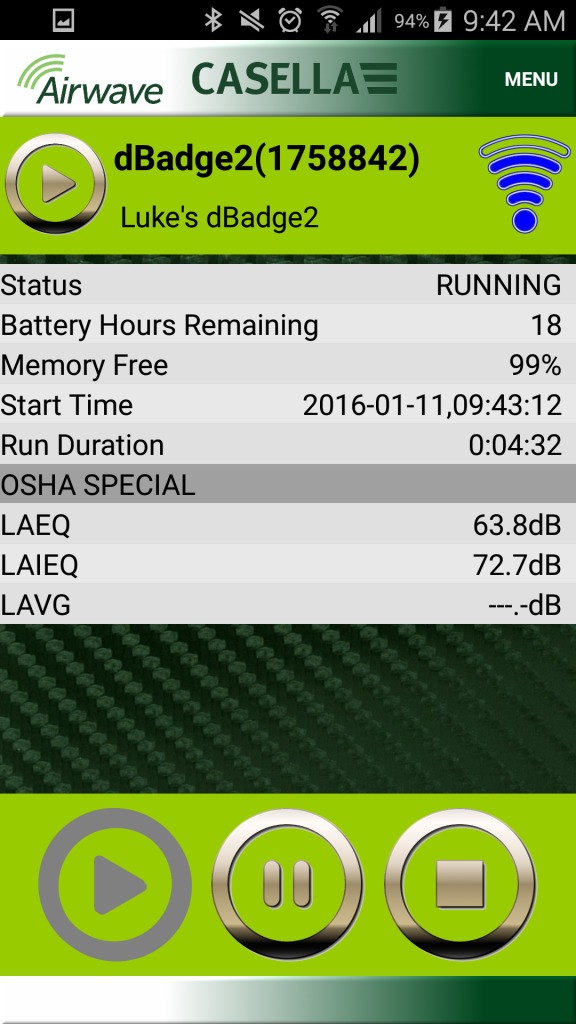There’s an app for that: Casella joins the health and safety tech party!
18 May 2016
Andrea Bowen, Technical Product Manager at Casella, explains why soon
we’ll all be bringing our own mobile devices to the noise and dust monitoring party!
From sleep
patterns to fitness trackers, the chances are you will use at least one app as
part of your everyday routine. For a vast majority of people, an app will be
the first thing they see in the morning and the last thing they see at night,
including newsfeeds, organisational apps and alarm clocks. As mobile phones and
technology become ever more mainstream, it is hard to ignore the obvious
benefits to our working life, so it makes sense that, by connecting our noise
and dust monitoring equipment to our mobile devices via Bluetooth, the health
and safety industry can embrace these developments too.
At the end of
2014, The Independent reported that
there were officially more mobile phones in the world than people.[1] In
the same quarter, Forbes magazine
reported that app downloads for 2014 were expected to reach approximately
179,628 billion, while predicting that downloads are expected to reach 268,692 billion
by 2017, based on data collected from the Apple app store alone.[2]
Apple currently offers users 1.4million apps for its compatible devices
according to a report from the company in January 2016.[3]
With such a large
number of both devices and apps in use, industries such as construction and
manufacturing would undoubtedly benefit from the advantages that come with
embracing mobile technology when it comes safety on a construction site or
workshop floor.
Alongside the
growing impact of mobile devices and technology, the awareness of exposure to
dangerous noise and dust levels continues to increase. Such hazards in the
workplace can and do lead to long term damage and illnesses. With this in mind
the BOHS, the Chartered Society for Worker Health Protection, is now offering
guidance on how to reduce occupational lung disease through its Breathe Freely
initiative, whilst the British Safety Industry Federation (BSIF) is raising
awareness of the dangers of occupational hearing loss with its Listen Today,
Hear Tomorrow campaign.[4]
Monitoring of
noise levels is key as hearing protection should only be used as a temporary
measure or last resort when no other options are available. 10 million people
in the UK have some degree of hearing loss and that figure is expected to rise
to around 14.5 million by 2031.[5] In
order to improve this, the implementation of effective noise monitoring is
essential and dust monitoring is no less important. In 2015, it’s estimated
that 3,500 died from cancer caused by past exposures to asbestos, 500 more from
silica dust, another 5,500 were diagnosed with occupational cancer, and - today
alone - an unknown but significant number will breathe in the hazardous
substances that will one day seriously affect their health or kill them.
By effectively
monitoring both noise and dust exposure, the impact of working conditions on
the health of workers will be significantly improved, leading to fewer long
term illnesses.
[1]http://www.independent.co.uk/life-style/gadgets-and-tech/news/there-are-officially-more-mobile-devices-than-people-in-the-world-9780518.html
[2]www.forbes.com/sites/niallmccarthy/2014/10/29/mobile-app-usage-by-the-numbers-infographic/
[3]https://www.apple.com/pr/library/2015/01/08App-Store-Rings-in-2015-with-New-Records.html
[4]http://bsif.co.uk/listen-today-hear-tomorrow
[5]ibid.
In order to implement the monitoring needed by an occupational
hygienist or health and safety professional, it must be done in a way that does
not impact upon the comfort or productivity of the worker. It is often remarked
that “We’d like the capability to monitor the device remotely without the need
to interfere with or disturb the worker” and with the use of mobile devices and
apps, we are able to easily overcome this.
Through the use of
Bluetooth and apps, occupational hygienists and health and safety professionals
are no longer required to physically follow workers throughout the day in order
to successfully monitor their working conditions. Be it in a confined space, a
unique environment or over a long distance or period of time, there’s no need
to disturb the wearer from what they’re doing.
This inspired
technological development allows the health and safety professional to view the
status of the pump, or even start, stop and pause the noise or dust monitoring
device directly from an app on their mobile device. With the addition of a
motion sensor to ensure wearer compliance, the chances of invalid data are
diminished and therefore confidence in the results is greatly increased, meaning that the data is more than sufficient for formulating
risk assessments and control decisions.
If mobile devices
and apps are such an integral part of life outside of our working environments,
why shouldn’t they have ‘app-positive’ impact on the way we work too? Our
ability to improve the occupational health of both ourselves and our colleagues
is of uppermost importance, so perhaps soon we’ll be saying BYOD – bring your
own device - to work!
List your business for free
Create a business listing on the SHP directory
Advertise with us
Download our media pack, and find out how we can meet your needs with a range of pricing options.


